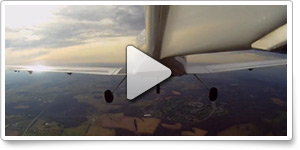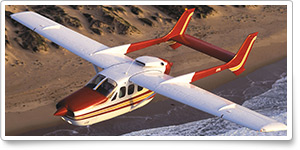| ||||||
| Back to ‘both’ |
| |||||
Training TipsBack to ‘both’ The ignition switch catches your eye. You discover to your chagrin that you have been flying along on one magneto. A turn of the key to the “both” position and the normal sound of cruise—and about 50 rpm—quickly return. You might ponder two lessons from this not-uncommon scenario: One is to pay better attention to detail when performing the pre-takeoff checklist, remembering to return the ignition switch to the “both” position after the mag check. The other is that it is safe to fly on one magneto if necessary. That’s what the dual-magneto ignition system that drives your trainer's engine was designed to make possible. Redundancy builds a safety margin into aircraft operations. When you first began to study the pilot’s operating handbook for your aircraft, you learned that the battery and alternator provide electrical power for systems and instruments, and that engine ignition was a separate system energized by gear-driven magnetos mounted at the rear of the engine. Plus, there are two magnetos, each with its own wiring for the associated spark plugs in the engine cylinders. During the pre-takeoff engine runup, you check the system by watching for an rpm drop as specified by the aircraft manufacturer for when one mag is operating. “Too great a drop in rpm can be an indication of several problems—anything from a fouled plug to a bad ignition wire to improper timing to a bad magneto. It needs to be checked by a mechanic,” explains the Flight Training article “The magneto check: What are you looking for?” No rpm drop? That’s also a sign of trouble requiring attention from the maintenance team before the aircraft flies again. An engine that suddenly begins to run roughly in flight despite being leaned properly and free of carburetor ice could be experiencing a malfunctioning magneto. Check each in turn: Roughness while running on one, and smooth operation on the other, helps isolate a diagnosis. Remain on the good magneto and return for a normal landing, knowing that a safety-minded design is working as it should. Flight Training NewsVermont instructor is 2012 CFI of the yearHobart Caleb “Hobie” Tomlinson of Huntington, Vt., was named 2012 National Certificated Flight Instructor of the Year. Tomlinson is one of four aviation professionals who received top accolades in the National GA Awards. Jeanne Carole Willerth of Lee's Summit, Mo., is the 2012 National FAASTeam Representative of the Year. Read more >> FAA publishes first officer qualification ruleThe FAA has published its expected notice of proposed rulemaking revising the qualifications for air carrier first officers. The rule would require all air carrier first officers to hold an airline transport pilot certificate instead of a commercial certificate, in effect increasing minimum flight hours from 250 to 1,500. The comment period closes April 30. Read more >> Don’t get caught behind the power curveYou learned early in your training about the fundamentals of flight. But those fundamentals are not just pieces of information to be discarded once you move on to mastering maneuvers. Behind every good landing and properly executed stall recovery is a solid understanding of aerodynamics. Without it, you run the risk of letting the airplane control you instead of vice versa. In the Essential Aerodynamics online course from the Air Safety Institute, you’ll learn about angle of attack, what causes stalls, how to avoid them, and much more. Take the course >> Icon, Microsoft make dreams a virtual realityFlying a sleek airplane built for two low over the Big Island of Hawaii may be a dream flight, but Microsoft and Icon have teamed to make that scenario a little more realistic. Microsoft launched its Microsoft Flight PC game, which offers the Icon A5 light sport aircraft flying over the Big Island of Hawaii as a free download. Read more >> Training ResourcesFlight training is a wonderful experience, but sometimes it can be difficult and challenging. That's why you may need some support to get you through those tough times. AOPA has a number of resources, not the least of which is the Let’s Go Flying website and its associated blog. The blog is filled with personal stories of those who have triumphed during the difficult times in flight training to become certificated pilots. There are tips, inspirational stories, and other advice a student might want or need along the way.
Did you know that student pilots who join AOPA are three times more likely to complete their flight training? Membership includes unlimited access to aviation information by phone (800/USA-AOPA, weekdays from 8:30 a.m. to 6 p.m. Eastern time) or from Flight Training Online or AOPA Online. If you're not already a member, join today and get the pilot’s edge. Login information is available online. Technique: Power-on stalls Career PilotSouthwest to open Denver crew baseSouthwest Airlines announced Feb. 24 that it will open a new pilot crew base at Denver International Airport in October. A flight attendant crew base will follow before the end of the year. The airline’s ninth crew domicile will be the base for at least 250 pilots and at least 4,000 flight attendants. The carrier began service to Denver on Jan. 3, 2006, with 13 daily nonstop departures to three destinations; now it operates 159 daily nonstops to 51 destinations. PSA, flight attendants reach tentative agreementPSA, a wholly owned US Airways subsidiary, announced Feb. 23 a tentative new collective bargaining agreement with Council 75 of the Association of Flight Attendants (AFA-CWA), which represents PSA's 268 flight attendants. The AFA Master Executive Council must first approve the tentative agreement before it can be sent to its members for consideration; this first step is expected to take place in the coming weeks. The tentative agreement would cover the airline's 268 flight attendants, who are based in Dayton, Ohio; Knoxville, Tenn.; and Charlotte, N.C. Plane SpotterCessna Skymaster: Two engines, two booms Training ProductsRich Stowell’s ‘Flying Tips’ from PilotMall.comFormer CFI of the year and Gold Seal flight instructor Rich Stowell shares some knowledge from his extensive aviation career on an audio CD. The 16 audio tips touch on subjects ranging from human factors, the fundamentals of aircraft control, and flying in the traffic pattern. The CD is $9.99 and is available from PilotMall.com.
Note: Products listed have not been evaluated by ePilot editors unless otherwise noted. AOPA assumes no responsibility for products or services listed or for claims or actions by manufacturers or vendors. Member BenefitsBank of America finances Marine’s first aircraftGabriel Glinsky started looking for an airplane to buy when he was deployed to Afghanistan. As a Marine Corps captain and V-22 Osprey pilot, Glinsky was looking for a general aviation airplane to use for pleasure flights when he returned home. Although he is an experienced pilot, he had never bought an airplane before, and didn't know what to expect when it came to financing. Read more >> Get a head start on summer vacation plansWhen you’re ready to start planning a vacation, help yourself and AOPA by making your travel plans through Orbitz. Orbitz will help you get the best deals on cruises, airfare, and hotels. To benefit AOPA, visit the Orbitz site via AOPA. Once you do that, you’re finished and you can navigate the Orbitz site as normal. A portion of what you spend on Orbitz will be returned to AOPA to continue the fight on behalf of general aviation. Don’t forget the car rental discounts that are yours as an AOPA member. Great deals are available from Alamo, Avis, Enterprise, and Hertz. All the information you need is online. BlogsSpring is just around the corner … and so are birdsThis week in the Flight Training blog:Technical Editor Jill Tallman asks if you have noticed any birds hanging out at your airport and warns that they could have designs on building a nest in your trainer. Professional pilot Chip Wright says if Mr. Murphy is going to make his presence known, he’ll likely be on board for the last leg of a multiple-day flight … and guess what happens. The return of Microsoft Flight Sim?Microsoft returned to the sim market last week with the launch of Microsoft Flight. Have you tried it? AOPA Pilot Technical Editor Mike Collins says you should know that the new product is being marketed more as a game, and asks for your feedback in the Reporting Points blog. AOPA Career OpportunitiesEver dream of turning your passion for aviation into a career? We’re looking for a manager of regulatory affairs, director of new market development, associate project manager, online product manager, marketing specialist–products, aviation education program developer, accounting manager, and associate editor–Web/ ePilot. To learn more about other AOPA career opportunities, visit AOPA Online. Community
AVIATION EVENTS & WEATHER
| ||||||||||||||||||||||||||||||||||||




 The trainer is cruising along as usual, but something isn’t quite right. The
The trainer is cruising along as usual, but something isn’t quite right. The 





